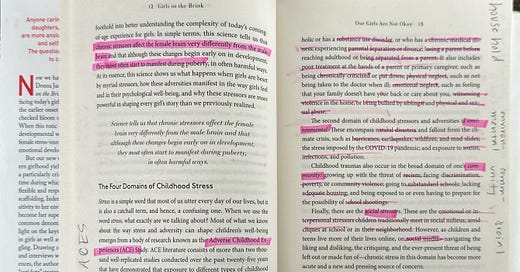How I Read So Much (And You Can Too)
Struggling to keep up with your reading? Here’s my process for reading high volumes without overwhelm.
People often ask me, How do you read so much? My answer? It’s a process born out of necessity after 25 years as a journalist, researcher, interviewer, and storyteller.
I’m constantly juggling research for future conference topics, prepping for present ones, or gathering insights to share for my personal brand. With so much going on, I rarely have the luxury of long, uninterrupted blocks of time for deep research. That’s why I’ve developed a flexible, adaptable method for reading high volumes that lets me fit it in wherever I can.
Today, I’m going to break down the exact tactics I use, by resource medium, so you can incorporate them into your own routine.
Here’s what we’ll cover:
How to annotate physical books in a time-saving way.
Why color-coding your notes helps organize key ideas.
My method for turning raw reading into actionable insights.
I receive a lot of physical books from publishers and authors, which is honestly my favorite kind of mail. The way I engage with these books, however, is all about efficiency.
My process for physical books:
Annotating:
I always have a pencil in hand—there’s something about a pencil that feels less intrusive than a pen or highlighter. I’ll underline parts that catch my attention, whether it’s an interesting idea, a core takeaway, or a framework the author has outlined.
My notes from Girls on the Brink by Donna Jackson Nakazawa. Context bts: read while chaperoning ten middle school boys at a trampoline park. Flagging pages:
This is the part that will save you a ton of tme later. I use small post-it notes to flag the margins of the pages. Each color has a meaning, and I create a key on the inside cover of the book to remind me. For example:Blue: Frameworks or methodologies
Pink/Red: Major takeaways
Yellow: Interesting quotes
The frameworks help you understand the author’s systems, the takeaways help you understand their mindset as simply as possible, and the quotes will help the author feel seen, heard and understood in a way that results in a much more engaging interview. Anyone can get a book summary online, quoting something remarkable back to them tells them you really gave it some attention.
Back when I was producing and directing shows like Who Do You Think You Are and The Voice, I used to flag our transcripts by theme—categories like tears, stakes, backstory, journey, and even “shit-talking.”
Writing questions and personal reflections:
In the front cover, I jot down any questions the reading brings up for me, along with personal anecdotes or reflections. I ask myself, How is this book challenging my thoughts feelings and behaviors? I also consider, How will someone watching an interview with this author respond—what do I hope they think, feel, and take away?
Before I interview an author, I go back through these notes, distill everything down, and pick the top five takeaways. These points will make the interview valuable for the audience, while also highlighting the author as the smart, insightful person they are.
3 Steps to Boost Your Reading Volume Without the Overwhelm
In order to get through a high volume of reading without feeling overloaded, you need a system. Here’s mine:
1. Make It Intentional
Underline key ideas, flag important pages, and write down questions or thoughts. This turns passive reading into a more active, engaged process. You’ll remember and use the information more effectively later on.
2. Create a Quick-Reference System
Color-coding and margin flagging allow you to organize your insights without needing to reread the whole book. It’s like building a mini index as you go.
3. Distill for Action
Once you’ve flagged, annotated, and reflected, the next step is to distill those ideas into practical takeaways. Whether you’re preparing for an interview, a podcast, or a conference, having these five key points at your fingertips will streamline the process.
If you’re someone who’s trying to level up your research process for interviews, conferences, or podcasts, here are a few resources to help you on your way:
Weekly Resource List:
Journaling and notetaking by Tim Ferriss (19-minute video)
A similar practice to mine with an extra step of action items at the end.Maria Popova speaking with Tim Ferris about note taking at the 31:45 mark
(1:45 podcast episode)
“Deep Work” by Cal Newport (6-hour audiobook)
Newport’s guide on how to focus intensely, even with a busy schedule.How to Read More by James Clear (15-minute read)
A helpful article on optimizing your reading habits when time is short.
Here’s what you learned today:
Reading with intent transforms how you absorb information.
Organizing as you read saves time and creates a reference system.
Breaking down your reading into actionable takeaways will help you turn knowledge into value for your audience.
The next time you pick up a book or research for your next project, try applying this process. It’s flexible, adaptable, and it’ll help you work more efficiently.
P.S. Physical books aren’t even my favorite way to read! All forms of reading count. I’ll get into ebooks and audio book approaches in my next newsletters.




